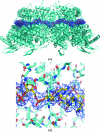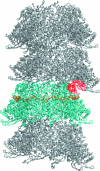Structures of respiratory syncytial virus nucleocapsid protein from two crystal forms: details of potential packing interactions in the native helical form
- PMID: 22102022
- PMCID: PMC3212357
- DOI: 10.1107/S1744309111029228
Structures of respiratory syncytial virus nucleocapsid protein from two crystal forms: details of potential packing interactions in the native helical form
Abstract
Respiratory syncytial virus (RSV) is a frequent cause of respiratory illness in infants, but there is currently no vaccine nor effective drug treatment against this virus. The RSV RNA genome is encapsidated and protected by a nucleocapsid protein; this RNA-nucleocapsid complex serves as a template for viral replication. Interest in the nucleocapsid protein has increased owing to its recent identification as the target site for novel anti-RSV compounds. The crystal structure of human respiratory syncytial virus nucleocapsid (HRSVN) was determined to 3.6 Å resolution from two crystal forms belonging to space groups P2(1)2(1)2(1) and P1, with one and four decameric rings per asymmetric unit, respectively. In contrast to a previous structure of HRSVN, the addition of phosphoprotein was not required to obtain diffraction-quality crystals. The HRSVN structures reported here, although similar to the recently published structure, present different molecular packing which may have some biological implications. The positions of the monomers are slightly shifted in the decamer, confirming the adaptability of the ring structure. The details of the inter-ring contacts in one crystal form revealed here suggest a basis for helical packing and that the stabilization of native HRSVN is via mainly ionic interactions.
© 2011 International Union of Crystallography. All rights reserved.
Figures





Similar articles
-
Crystallization and preliminary X-ray analysis of the human respiratory syncytial virus nucleocapsid protein.Acta Crystallogr Sect F Struct Biol Cryst Commun. 2008 Nov 1;64(Pt 11):1019-23. doi: 10.1107/S1744309108031059. Epub 2008 Oct 28. Acta Crystallogr Sect F Struct Biol Cryst Commun. 2008. PMID: 18997331 Free PMC article.
-
A Druggable Pocket at the Nucleocapsid/Phosphoprotein Interaction Site of Human Respiratory Syncytial Virus.J Virol. 2015 Nov;89(21):11129-43. doi: 10.1128/JVI.01612-15. Epub 2015 Aug 5. J Virol. 2015. PMID: 26246564 Free PMC article.
-
Crystal structure of a nucleocapsid-like nucleoprotein-RNA complex of respiratory syncytial virus.Science. 2009 Nov 27;326(5957):1279-83. doi: 10.1126/science.1177634. Science. 2009. PMID: 19965480
-
The nucleocapsid of vesicular stomatitis virus.Sci China Life Sci. 2012 Apr;55(4):291-300. doi: 10.1007/s11427-012-4307-x. Epub 2012 May 9. Sci China Life Sci. 2012. PMID: 22566085 Review.
-
Structural Insights into the Respiratory Syncytial Virus RNA Synthesis Complexes.Viruses. 2021 May 5;13(5):834. doi: 10.3390/v13050834. Viruses. 2021. PMID: 34063087 Free PMC article. Review.
Cited by
-
Human Respiratory Syncytial Virus: Infection and Pathology.Semin Respir Crit Care Med. 2016 Aug;37(4):522-37. doi: 10.1055/s-0036-1584799. Epub 2016 Aug 3. Semin Respir Crit Care Med. 2016. PMID: 27486734 Free PMC article. Review.
-
Structural Basis of Human Parainfluenza Virus 3 Unassembled Nucleoprotein in Complex with Its Viral Chaperone.J Virol. 2022 Jan 26;96(2):e0164821. doi: 10.1128/JVI.01648-21. Epub 2021 Nov 3. J Virol. 2022. PMID: 34730394 Free PMC article.
-
Contribution of Fcγ Receptor-Mediated Immunity to the Pathogenesis Caused by the Human Respiratory Syncytial Virus.Front Cell Infect Microbiol. 2019 Mar 29;9:75. doi: 10.3389/fcimb.2019.00075. eCollection 2019. Front Cell Infect Microbiol. 2019. PMID: 30984626 Free PMC article. Review.
-
Quantitative investigation of the affinity of human respiratory syncytial virus phosphoprotein C-terminus binding to nucleocapsid protein.Virol J. 2014 Nov 19;11:191. doi: 10.1186/s12985-014-0191-2. Virol J. 2014. PMID: 25407889 Free PMC article.
-
Structural analysis of respiratory syncytial virus reveals the position of M2-1 between the matrix protein and the ribonucleoprotein complex.J Virol. 2014 Jul;88(13):7602-17. doi: 10.1128/JVI.00256-14. Epub 2014 Apr 23. J Virol. 2014. PMID: 24760890 Free PMC article.
References
-
- Albertini, A. A., Wernimont, A. K., Muziol, T., Ravelli, R. B., Clapier, C. R., Schoehn, G., Weissenhorn, W. & Ruigrok, R. W. (2006). Science, 313, 360–363. - PubMed
-
- Bhella, D., Ralph, A., Murphy, L. B. & Yeo, R. P. (2002). J. Gen. Virol. 83, 1831–1839. - PubMed
-
- Boyce, T. G., Mellen, B. G., Mitchel, E. F., Wright, P. F. & Griffin, M. R. (2000). J. Pediatr. 137, 865–870. - PubMed
-
- Brünger, A. T., Adams, P. D., Clore, G. M., DeLano, W. L., Gros, P., Grosse-Kunstleve, R. W., Jiang, J.-S., Kuszewski, J., Nilges, M., Pannu, N. S., Read, R. J., Rice, L. M., Simonson, T. & Warren, G. L. (1998). Acta Cryst. D54, 905–921. - PubMed
MeSH terms
Substances
Associated data
- Actions
- Actions
- Actions
LinkOut - more resources
Full Text Sources

